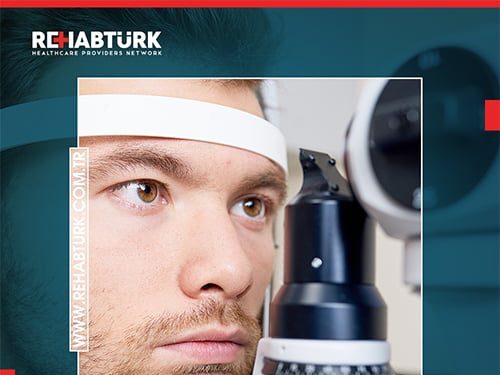Corneal refractive surgery in Türkiye
Corneal refractive surgery is a type of laser eye surgery. It is used to improve vision by correcting refractive errors in the eye.
Myopia (nearsightedness), hyperopia (farsightedness), and astigmatism are examples of refractive errors. The patient may undergo surgery on one or both eyes, depending on his needs.
Corneal refractive surgery and LASIK surgery are similar as they both work by reshaping the cornea, which is the clear front part of the eye. This improves the eye’s ability to focus.
Some people are good candidates for both corneal refractive surgery and LASIK. Others are considered more appropriate to one or the other. It is important for the patient to know about “corneal refractive surgery” and how it differs from other eye surgeries before deciding on the best option.
Corneal refractive surgery
To start the corneal refractive surgery, specific instructions are discussed with the doctor before the date of the surgery, as there are many steps that the patient must take before the operation.
before surgery

There will be an appointment before surgery for an eye evaluation and vision test. Then the refractive error and pupillary are measured in each eye and the shape of the cornea is mapped in preparation for surgery. Accordingly, the laser used during the procedure is programmed.
You should tell your doctor about any prescription and regular medications you use. It may need to be temporarily suspended. In the event that antihistamines are used, the doctor may ask to stop taking them three days before the scheduled surgery date.
When using hard contact lenses, your doctor may tell you to stop wearing them at least three weeks before surgery. Other types of contact lenses also usually must be discontinued one week before the procedure.
The doctor may prescribe antibiotic eye drops, such as “Zymaxid”, to start using them three to four days before surgery. You must continue to take these medicines after the operation for about a week. The doctor may also recommend eye drops for dry eyes.
Approximately three days before surgery, the patient should start cleaning the area around the eye completely, emptying the sebaceous glands located near the eyelash line. Place a warm or hot compress on the eyes for five minutes.
Then the fingers are gently passed over the upper eyelid from the inside near the nose to the outside near the ear. This is required two or three times for the upper and lower lash lines. Eyelids and eyelashes are washed thoroughly with a gentle, non-irritating soap or baby shampoo. The whole process is repeated twice each day.
surgery day
Arrangements should be made for someone to drive after the operation because the patient will not be able to drive and may feel very tired after the corneal refractive surgery.
It’s a good idea to have a snack before arriving for the appointment. You should expect to stay in the clinic for several hours. Unless otherwise notified, medication prescribed by a physician should be taken.
No makeup or anything that might interfere with the surgeon’s ability to position the head under the laser should not be applied. Other accessories to avoid include barrettes, scarves, and earrings.
Comfortable clothes must be worn during the procedure. If there is an illness or a fever, or if the patient is not feeling well in any way, the doctor should be contacted and asked if the procedure should be continued.
The doctor is asked if eye drops or any other medicine should be brought to the treatment.
Surgical procedure
The refractive keratectomy procedure takes 5 to 10 minutes per eye. This type of surgery does not require general anesthesia. The patient may be given local anesthesia or numbing eye drops.
during the procedure
An eyelid mask is placed on each eye to prevent it from blinking.
The surgeon then removes and disposes of the corneal surface cells from the eye. This can be done with a laser, a razor, an alcohol solution, or a brush.
A laser programmed with the eye’s measurements reshapes the cornea using a pulsed beam of ultraviolet light. There may be a series of beeps while doing this.
A transparent contact lens is placed over each eye like a bandage, keeping the eye clean and avoiding infection during the healing process. Contact lenses or “bandages” remain on the eyes for several days to a week.
Side effects of corneal refractive surgery
Discomfort or pain may be felt for up to three days after corneal refractive surgery. Over-the-counter pain relievers are often sufficient to deal with this discomfort.
If you are worried about pain or feel unbearable pain then ask your doctor to prescribe pain medication. In addition, there may be irritation or tears in the eyes as well.
The patient may feel that his eyes are more sensitive to light during their recovery period. Some people also see halos, or flashes of light, for days or weeks after corneal refractive surgery, especially at night.
The patient may also experience corneal cloudiness, which is a cloudy layer that can significantly impede vision for a short period of time after surgery.
While corneal refractive surgery is considered safe! It is not without risks.
The risks include:
- Vision loss that cannot be corrected with glasses or contact lenses.
- Permanent changes in night vision, which include seeing glares and halos.
- double vision
- severe or persistent dryness
- Results diminish over time, especially in the elderly and hyperopia patients.
Recovery after corneal refractive surgery
The patient takes a break in the clinic and then goes home after the surgery. Nothing else should be done for that day but rest. Keeping eyes closed may help with recovery and overall comfort level.
Your doctor may want to see you the day after the procedure to assess your results and comfort level. You should contact your doctor immediately if you notice any signs of an eye infection, such as:
- redness
- pus
- swelling
- Fever
Tell your doctor immediately if a bandage contact lens has been dislodged or fallen off. You must return within seven days to remove the lenses from the eyes.
Vision may initially be better than it was before the procedure. However, the vision will become somewhat blurry for the first few days of recovery. Then you will noticeably improve. Many people notice an improvement in vision when their contact lenses are removed from the pads.
Do not rub the eyes or remove the lenses that cover them. Keep cosmetics, soaps, shampoos, and other items out of the eyes for at least a week.
The doctor may recommend taking time off from work while the eyes are healing. A doctor should be consulted regarding driving, reading and computer use. These types of activities will be difficult at first and driving should be avoided until the blurry eyes are gone, especially at night.
You should also prevent sweat from getting into the eyes for at least a week, as this can cause irritation. In addition to staying away from sports that require physical contact or any activity that may cause eye injury for at least a month.
Wearing protective eye gear for several months is a good idea. Swimming and other water sports should be avoided for several weeks, and even with goggles, dust or dirt should not get into the eyes for the same amount of time.
It may take several weeks before vision stabilizes completely. Vision usually improves by about 80% after one month, and 95% by three months. About 90% of people achieve 20/40 vision or better by three months after surgery. Eyes should be protected from bright sunlight for about a year and sunglasses should be worn on sunny days.
Corneal refractive surgery cost
The cost of corneal refractive surgery varies according to the location, the doctor, and the details of the disease. But on average it can range from $1,800 to $4,000 for corneal refractive surgery.
Corneal refractive surgery vs. LASIK
Both corneal refractive surgery and LASIK are designed to correct refractive vision problems by reshaping the cornea. Both procedures use lasers and take about the same time to perform.
In corneal refractive surgery, the surgeon removes and thins out the outer epithelial layer of the cornea, leaving the eye exposed before reshaping the cornea. This layer renews itself and grows again over time.
In LASIK , the surgeon partially cuts a strip of the epithelial layer and moves it away in order to reshape the cornea underneath . This is usually done with a laser and without blades. The cut remains attached to the cornea and is put back in place after the procedure is complete.
To be eligible for LASIK surgery, you must have enough corneal tissue to create this flap. For this reason, LASIK may not be suitable for people with very low vision or corneal impairment.
The procedures also differ in terms of recovery time and side effects. Healing and vision stabilization is slower in corneal refractive surgery than in LASIK surgery. People who undergo corneal refractive surgery can also expect discomfort afterward as well as other side effects such as corneal clouding.
Success rates are similar for both procedures
Advantages of corneal refractive surgery
- It can be performed on patients with thin corneas or poor corneal tissue with poor vision or severe myopia.
- Less expensive than LASIK
- Reducing the risk of complications caused by chip cutting
- The possibility of dry eye in photorefractive keratectomy is minimal.
Disadvantages of corneal refractive surgery
- Healing and visual recovery take longer because the outer layer of the cornea needs to renew itself.
- The risk of infection is slightly higher than with LASIK.
- Blurry vision, discomfort, and sensitivity to light commonly felt while wearing a bandage contact lens during the healing period.
How can I book for corneal refractive surgery in Türkiye?

- Free medical support on the phone: You will have a dedicated representative for your health condition who is always ready to answer your questions.
- Free consultation with a specialist doctor: Your medical representative will consult with a number of doctors and hospitals to find the best possible treatments.
- Free travel visa arrangement: We will contact the embassy in your country to assist you in obtaining a visa to visit Türkiye.
- Free itinerary planning: We will create a schedule for your medical trip to Türkiye.
- Free translation of documents and reports: We will translate medical documents and reports into Turkish on your behalf.
- Free support and monitoring: We will monitor the stages of treatment and be by your side every step of the way.
- Free instant translation: We will be with you during the treatment stages to provide translation between you and the medical team.
- Free accommodation and transportation coordination: We will book accommodation for you and your companions in Türkiye, along with transportation services.
Contact REHABTÜRK doctors for more information about the procedure and to evaluate your medical condition.

